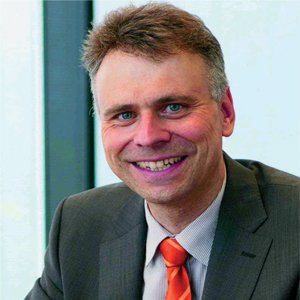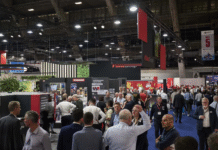
Since 1979, the Austrian automation company, B&R Automation, has steadily grown to now 2,700 members of staff at 200 locations worldwide; half of them engineers. For years, the sales increases have been in the two-digit range and in 2014 amounted to approximately 535 million Euros. The success is above all due to the growing demand for interlinked process chains in printing technology manufacturing. In an interview, conducted by Peter Trechow, Markus Sandhöfner, general manager of B&R Germany, and Robert Kickinger, specialist for printing technology and mechatronics at B&R, explain why they see digital printing and shorter printruns as drivers of automation and networking, how printing technology manufacturing became a pioneer of Industry 4.0 and why it will be easier in future to realize flexible machine concepts for fast turnarounds.
Peter Trechow: Would you please elucidate on B&R Automation in a few words?
Markus Sandhöfner:With pleasure. B&R was founded in 1979 by Erwin Bernecker and Josef Rainer. The first product was our own development, a counter board, which soon led to the automated drive technology.In the 1980s,therewere the firstmotion control applications, followed by the firstCNCsolutions in the 1990s. Forthem, fast counters, fast drive and control technologies like those developed by B&R were in demand. At the end of the 1990s, a pioneering decision was made – our range of products onoffer comprised control devices withmotioncontrolfunctions, our own industrial PCs, visualization solutions and software. The logical next step was the entry into the drive amplifier technology. We built a first line of servo drives that quashedall other previous approaches.Insteadof a separationofdrives onone side and the control unit with motion controller on the other side, B&R concentrated on full integration. The underlying idea was – integration is the key to transparency between different systems andwill provide diagnostic data fromthe drives forthe control, visualization and, in addition, process analyses.
Trechow: How would you describe your entry into networked processes?
Sandhöfner: The step away from analogous interfaces in the direction of a completely digital process was revolutionary at that time. And the result was that we needed more bandwidth and faster data transfer than could be achieved with the fieldbus used at that time. We were able to control the processes better and more precisely, but due to the growing number of networked components, the fieldbus ran up against its limits. In order to turn the potential of digitalization into higher productivity and precision, B&R as the first industrial company worldwide concentrated on the real-time Ethernet – and did that even before the turn of the millennium. By the way, the demand at that time stemmed from printing technology which pushed open the doorto the networked process world of Industry 4.0.
Trechow: What happened next?
Sandhöfner: With the know-how as regards drive technology, its synchronization and the complete integration as well as digital real-time networking, B&R had optimal conditions to establish itself in the printing industry. Previously we had customers active in automated print finishing. In the 2000s, we succeeded in finding our way into printing technology manufacturing. Since the beginning of the crisis in 2007, we have noticed thatthe printing machinery manufacturers are paying close attentionto theirtechnologicalfuture.Intheir searchforflexible solutions for automation and networking, leading manufacturers of machines and systems have found their way tous. By theway,many ofthesemanufacturers are also fromthedigitalprinting sector.
Trechow: So, the radical change in the printing industry is rather positive for B&R?
Sandhöfner: Yes, one can say that. The industry is forced to reorient itself. The demand shifts in the direction of shorter printruns and individualized print products. It spurs digital printing where our solutions have been in demand right from the start. And then, there are new technologies like 3Dprinting and printing onthree-dimensional products. In the market, we will soon see solutions that are used to print on cars and trucks.As far as this is concerned, we can utilize our automation knowhow from other industrial sectors, our know-how concerning robotics in the automotive industry and packaging industrywherewehave beentraditionally strong.In allthese cases, itis importantto synchronizemultiple axes,tobe able tomove along them at varying speeds and, at the same time, to ensure highest precision and throughputs.
Trechow: How does B&R organize the know-how transfer between the industrial sectors?
Robert Kickinger:Actually,that’s implicit. In the printing industry,this requirementis called convergence. Look at the 4D system of Heidelberg which can produce individual prints on footballs. Forthat, the objects must be laser-scanned, then printed using the inkjet technology, with the orientation of the printing heads being based on high-precision robotics andCNCtechnology. Due to the many industrial sectors we are involved in,wehave allthe required basic technologies ready to choose from in ourrange of modules. This is no doubt a key to our global success. Furthermore, we continuously invest 15% of our sales in research and development.
Sandhöfner: Added to that, our engineers in the development department cooperate closely with our customers. Therefore, our application specialists work with the latest machines. The combinationofthemachinery and process know-howof our customers with our automation know-how consistently renders new innovative ideas and solutions.
Trechow: What are your focal industrial sectors?
Kickinger: In the printing industry, historically B&R originated in the postpress area as well as the still very healthy packaging printing sector. In the course of the last few years, B&R also established itself as a partner of printing machinery manufacturers. Since we could additionally break new ground with large digital printing companies like HP, the printing sectoris continually gaining in importance for us.
Trechow: The trend to shorter runs, personalization andindividualization requires flexible plants with short makeready times. To what extent is that compatible with the automation solutions of B&R?
Kickinger: It’s all about the cost-efficient production of small batch sizes in high, reproducible quality. This results in requirements onmachines and equipment –minimum wastage, maximum availability, fast turnaround times from one orderto the next. It’s no longer a question of whether a system runs at 300 or 350 metres a minute. It’s rather how fast can I change overfrom one orderto another? How is the energy and resources efficiency? Which possibilities are there as regards in-line quality control and how do I get the digital process data? This is exactly where our solutions come in . . .
Sandhöfner: Printing companies which align their process world with an intelligent and flexible orientation still buy machines and make good money with them. It’s a change in paradigm driven by the electronic media and digital printing. The digital process chains of Industry 4.0 are nowhere more advanced than in the printing industry. In this respect, it is an absolute pioneer. A shining example of that is the online printing company.
Trechow: Indeed, and we even talk about Print 4.0. But back to B&R. Isn’t there a contradiction between declining batch sizes and automation?
Sandhöfner: Here, it’s worth looking at details, starting with the hardware. Any customer who orders an industrial PC from us can tailor a device choosing from250 billion configur- ations – batch size 1,whichwe document, including the serial number of all incorporated components and including the functional tests in our SAP system.Maintenance and service are considered in production already. For our customers from the engineering sector, we have also built up a range of software modules with all basic functions of a machine. Thanks to this modular design of the hardware and software configurations, the rectification of possible failures is carried out only once and centrally. Customers can simply combine the required functionalities fromthis quality-assured software pool anduse their expertise forthe development of distinctive features. Here again, the full integration of hardware and software is the key element.
Kickinger: Customers from the printing technology sector can also profit from this framework, which we call mapp for modular application platform. It enables them to implement new developments fast and efficiently. The increasing complexity of themachines that allowautomatic productionof small batchsizes downto just one piece would otherwise strongly increase the expenses forthe development of software for the machine control. Where formerly the axes of ancillary drives were set manually, this is now done automatically. In addition, the requirements regarding the design and usability ofthe man-machine-interface are continuously increasing inthe age ofthe smartphone generation.Our prefabricatedmapp components support the developing engineer. Therefore, project expenses can be substantially reduced.
Trechow: What does that look like in practice?
Sandhöfner: Let’s take, for example, energy consumption. In our drive solutions, itis
tracked with current and voltage sensors anyhow. Our software modules enable to
combine these data automatically and to have a look at the energy consumption of
each drive individually. Ifrequested, this can also be combined with the number of
products produced. As a result, I have the energy consumption per product, per
batch or per period of time immediately. All processes get transparent. This, of
course, also enables to implement conditionmonitoring, proactivemaintenance or
the exchange ofwear parts according to the actualwear status instead of according
to stricttime constraints. It’s also possible to ensure protection against cyber criminals by firewalls.And, whatis important – whenever a modular system is designed
for a new order, it is automatically checked whether the new configuration is functionally safe are not.We are the only provider worldwide who offers that.We also offer plug&play functionality for maintenance. When, for example, one drive in the
system fails,the system diagnosis manager shows which drive itis. If it needs to be replaced, the suitable firmware is automatically downloaded from the control. All
this minimizes downtimes and makeready times.
Trechow: You offer ultra-fast automation with response times of less than one microsecond. How relevant is that for the printing industry?
Kickinger:Gravure printing machines run at 600 metres a minute – thatis, 10 metres a second.Atthe same time, ahigh-quality printed imagewithmicrometre precision is requested. Therefore, the signal processing speed is, of course, very important. The position of the register marks with which multi-color prints are synchronized must be detected by the sensor systemwiththehighest precision. Forthat,ultrafast data processing is required. In conjunction with the control of the drives, we talk about high-precision motion control, which we supplement with our market-leading range of auto-adaptive solutions.
Sandhöfner: This reflects our basic strategy.Withourmodular solutions,wehelp our customers to implement Industry 4.0 in their machines and plants. We give advice and accompany them allthe way from the concept stage to commissioning.We are firmly convinced that automation and networking are the enablers of the economic production of shorter and shorter, individualized printruns – down to batch size 1. It can provide the necessary flexibility. In addition, it paves the way for new dimensions. Just think, for example, of 3D printing.
The above interviewwas conducted by VDMA(GermanEngineering Federation)Printing and Paper Technology Association











